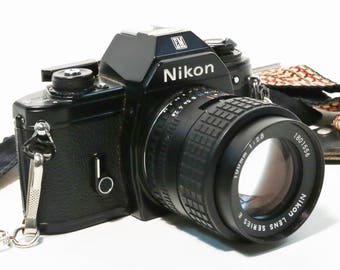THE NIKON EM (Updated 15-JUN-2016) At first glance, the Nikon EM looks almost too simple to be taken seriously. It's tiny, uncluttered, and if you were to remove the NIKON logo off the pentaprism, you'd never guess who made it. To appreciate the true qualities of this superb little SLR, you need to take a deeper look. Merlin's Nikon EM body Being a long time Nikon fan and owning an F3HP and a Nikkormat FT3, you might think I'm too biased to give a truly objective view - after all, this is an entry-level SLR, and there were plenty of similar cameras around to choose from at back in 1979 when the EM was introduced. But I bought my EM just because I wanted a Nikon that my wife could use, or to be kept in the car for emergencies.
I wasn't doing it justice! Since the EM is aperture priority auto only - you set the lens aperture and the camera sorts out exposure for you - I was skeptical. No shutter control?
I bought Nikon EM camera about a year ago to learn. The other review regarding lens compatibility is a bit unfair as this camera was designed for manual focus F mount. Find great deals on eBay for nikon em manual and nikon fg-20. Shop with confidence.

No EV compensation? How can it possibly get me good slides? Free Google Book Downloader Programs. Well, it does, consistently and reliably. The first clue you get that this camera is indeed made of sterner stuff is when you cock the shutter. The unusual winding lever has a kind of knee joint that flips sweetly out when you use it and clicks back out of the way when you're done - a charming feature. You can also wind in several multiple strokes, and film transports smoothly.

A light squeeze on the shutter button, and the meter comes on. A simple needle on the left hand side of your viewfinder moves up and down the shutter speed scale.
Speeds below 1/30th are shaded in red, to warn you you're risking camera shake, and if the needle goes into this area with your finger still on the button, you get a discrete acoustic warning, too - a soft beep. Squeezing off the shot is predictable and smooth.
Using the EM, you'll find the metering system does a startlingly good job of sorting out MOST situations, and for backlit subjects, a little button on the camera front (a bit awkward to use) slows the speed down two stops to compensate. The EM, in spite of Nikons use of polycarbonate for the top and bottom plate, feels solid and handles nicely, even if you have banana fingers like me.
You never get the feeling you've got a cheapie in your hands. Not a Nikon for the purists, but a true Nikon nevertheless. A pessimist would list all the things you cant do with the EM, but it's much fairer to judge what it can.
For very little money, you get a no-frills SLR, delightfully easy to use, that will produce consistently good results for most situations. The EM can even be motorized, either with the respectably fast 3.2 fps MD-14 or a slower 2 fps winder. But by adding a motor you lose the advantage of a small camera, and it becomes as bulky as any other powered SLR. For more 'professional' features like depth of field preview, manual speed control, EV compensation, mirror lock and so on, you really need a different camera. But for the ability to take good photos without a lot of fuss, it's unbeatable. It works with most of the AI-Nikkor lenses (some special wide angles need a mirror lock and would damage the camera) and Nikon introduced the E series lenses at about the same time - a low budget alternative. It won't, however, work with the older non-AI lenses with the prong coupling, and attempting to mount one could screw up the meter coupling on the bayonet.
By the way, a reader asked me about the silver rewind knob - I think it's an unpainted original, but it must be the result of a repair long ago before I got it. Normally they come in black. Definitely a camera worth owning! For less than the price of a good coffee machine. A second review on the Nikon EM By J. Ramon Palacios (jrp) Updated 15-JUN-2016 Released in the spring of 1979, at 1 lb. Or 460 g in weight, this camera was not only lighter than any of its predecessors and somewhat smaller; it was also inexpensive and quite uncomplicated.
Designed for mass marketing and intended to appeal to new photographers, its simplified operation was a delight while sharing the same ruggedness and reliability of the well proven F Pro Series and the Nikkormat Series (Nikomat in Japan), with a die-cast aluminum alloy chassis. Nikon EM with 50mm f/1.8 E lens This was a 35mm film camera, 24x36mm reflex with a built-in center-weighted light meter with a sensitivity range of EV 2 to 18, using one SPD cell. The meter range was from 25 to 1600 ASA (now ISO). The shutter stepless speed range was from 1 to 1/1000s and a Bulb electronic setting. The shutter was a vertical travel metal focal plane type. It could use either of two motor film winders, the MD-E (2 frames per second or fps, with 6 AAA batteries) and the not so preferred due it its weight, the MD-14 (3 fps, with 8 AA batteries), later introduced for the Nikon FG. With an aperture priority auto exposure, the shutter speed match-needle scale was visible on the viewfinder and it had an audible and annoying warning alarm when the exposure was incorrect or the shutter speed too low to make crisp images when handholding (under 1/30s).